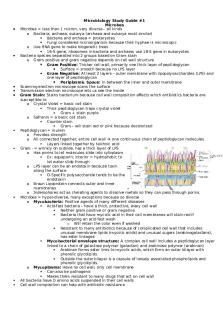BIOL 103 Chapter 1: The Main Themes of Microbiology PDF

| Title | BIOL 103 Chapter 1: The Main Themes of Microbiology |
|---|---|
| Author | Dominique Guimond |
| Course | Basic Bacteriology |
| Institution | Old Dominion University |
| Pages | 5 |
| File Size | 136.9 KB |
| File Type | |
| Total Downloads | 4 |
| Total Views | 138 |
Summary
Prof. McCallister, This chapter talks about the basics of bacteriology and microbiology...
Description
BIOL 103 1/11/17 and 1/16/17 Chapter 1: The Main Themes of Microbiology What is microbiology? Micro =small; biology= study of life Microbiology: study of microorganisms Microorganisms: living organisms that cannot be seen with the naked eye (i.e. microbes, bugs, germs) The Scope of Microbiology What does it include? Encompasses ALL types and aspects of microbes Types of microorganisms: bacteria, algae, protozoa, helminths, fungi, archaea, viruses, prions (infectious proteins; mad cow disease) Microbial impact on Earth (Importance of Microbes) 1. Origins and Evolution: they are our ancestors; evolution 2. Environment: they impact the environment; they’re ubiquitous (they’re everywhere!); they’re there in large numbers; impact Earth’s terrain (photosynthesis and decomposition); 70% of photosynthesis is done by microbes (some bacteria and algae). Decomposition is performed by fungi and bacteria. 3. Biotechnology (use of microorganisms or their products in the commercial or industrial realm; genetic engineering: manipulation of living organisms to create new products): food (microbes are used to make foods like: bread, beer, cheese, wine, yogurt, milk), mining (use of microbes to
extract minerals), cleaning products (enzymes that microbes can produce; diatomaceous earth: cleaning agent made from algae), drug therapy (manipulate microbes to create insulin (yeasts) and antibiotics (bacteria and fungi)). Bioremediation: introduction of microbes into the environment to restore stability or to clean up toxic pollutant; many kinds of microbes working together i.e. Oil spills, heavy metals, etc. 4. Disease (Microbial Diseases): only a small percent of microbes cause infectious diseases (pathogens); some improve the quality of life (normal biota). Increasing number of emerging (Zika, bird/swine flu) and re-emerging (measles, Ebola, hepatitis, AIDS) diseases; new links of diseases to microbes (stomach ulcers, some cancers, OCD, anxiety, depression); increasing number of drug resistant strains of diseases. (MRSA (bacterial/staph infection), gonorrhea, VRSA, and MRTB) General Characteristics of Microorganisms o Cellular and acellular Cellular Prokaryotes: bacteria, and archaea Eukaryotes: fungi, protists (algae and protozoa), and helminths Prokaryotes No organelles 10x smaller Unicellular Cell walls All prokaryotes are microorganisms 2
Eukaryotes Organelles 10x larger Uni/multicellular Cell walls? (not all have cell walls) Not all eukaryotes are microorganisms Acellular Viruses & Prions Viruses Acellular Obligate intracellular parasites Cannot live independently – need a host Much simpler than a cell o Only consist of genetic material and protein o Use host machinery to replicate and disperse Prions Single protein Characteristics of Living organisms: metabolism, reproductions, differentiation, communication, locomotion, and evolution Microbe size: 1 mm (fungi) – 1 nm (prions) Naming, Classifying, and Identifying Microorganisms
3
Taxonomy: classification of life (domain, kingdom, phylum, class, order, family, genus, and species); Dear King Philip Came Over For Soup Nomenclature Binomial system of nomenclature Consists of two names genus and species Rules Genus name is always capitalized Species name is never capitalized Both are either written in italics or underlined Origins of Classification Evolution: underlying theme of all biology Similar features because they share a similar ancestor Different Classification Schemes Whittaker: The 5 Kingdom Model Plants Animals Fungi Protists Monera Woese: The 3 Domain Model Domain Bacteria: most abundant organism, structurally simple, not membrane bound (nucleoid), cell wall made of peptidoglycan, some are photosynthetic, distinct shapes, and some are motile, come in rods, circles and, spirals
4
Domain Archaea: prokaryotes with unique chemistry Domain Eukarya: contains eukaryotes; protista (protozoa and algae), fungi (mold and yeast), and animalia (helminths)
5...
Similar Free PDFs

Apush - Chapter 6 Main Themes
- 3 Pages

BIOL 2420 Microbiology Chapter 3
- 2 Pages

Jane Eyre Main Themes
- 2 Pages

Microbiology Chapter 1
- 6 Pages

The Last of the Mohicans Themes
- 5 Pages

Omelec 103-Chapter 10Summary
- 9 Pages

The Iliad - Themes - Summary
- 5 Pages

BIOL 260 Chapter 5 The Human Tissues
- 10 Pages

Oedipus the King Themes
- 2 Pages
Popular Institutions
- Tinajero National High School - Annex
- Politeknik Caltex Riau
- Yokohama City University
- SGT University
- University of Al-Qadisiyah
- Divine Word College of Vigan
- Techniek College Rotterdam
- Universidade de Santiago
- Universiti Teknologi MARA Cawangan Johor Kampus Pasir Gudang
- Poltekkes Kemenkes Yogyakarta
- Baguio City National High School
- Colegio san marcos
- preparatoria uno
- Centro de Bachillerato Tecnológico Industrial y de Servicios No. 107
- Dalian Maritime University
- Quang Trung Secondary School
- Colegio Tecnológico en Informática
- Corporación Regional de Educación Superior
- Grupo CEDVA
- Dar Al Uloom University
- Centro de Estudios Preuniversitarios de la Universidad Nacional de Ingeniería
- 上智大学
- Aakash International School, Nuna Majara
- San Felipe Neri Catholic School
- Kang Chiao International School - New Taipei City
- Misamis Occidental National High School
- Institución Educativa Escuela Normal Juan Ladrilleros
- Kolehiyo ng Pantukan
- Batanes State College
- Instituto Continental
- Sekolah Menengah Kejuruan Kesehatan Kaltara (Tarakan)
- Colegio de La Inmaculada Concepcion - Cebu






